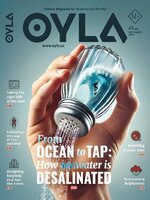OYLA Magazine is a science and technology publication for readers aged 12 and up. It features engaging articles, interactive content, and stunning visuals designed to inspire curiosity and a love for learning. Ideal for young minds eager to explore and understand the world around them.
OYLA MAGAZINE
WE’RE ALL A BIT . . . ROBOTIC
The DOPPLER EFFECT
Chemical Elements: Common and Rare • There are 94 elements that occur naturally on Earth, and 24 more that can be obtained synthetically. Among these are both common and rare elements. The same element can be very common on the scale of the universe but, at the same time, quite rare on our planet, and vice versa. Even on Earth itself, the elements are unevenly distributed. How did this happen?
CLASH OF THE HUNTERS
OUR SPIDER NEIGHBORS: FRIENDLIER THAN YOU THINK • Spiders don’t really mean to be aggressive towards us. If they have the opportunity to escape, they will do just that. After all, for a little spider, any human is a mysterious threat of immense proportions, and often fatal at that! So how about we declare a truce with our eight-legged friends and try to get to know them a little better?
REPEAT AFTER ME • Scientific experiments must be reproducible, meaning that any researcher repeating their colleagues’ experiments should obtain the same results. However, recently doctors, psychologists, and sociologists have admitted that they often receive completely different data compared to the authors of the original studies. Why does this happen and what can we do about it, especially considering that some of these experiments have already been included in textbooks?
THE SHAPE OF THE TABLET • Why are most tablets made in the form of white circles with flat or slightly convex surfaces? Why do you have to wash them down with plenty of water? And how do you store them properly? In this article we have collected the most frequently asked questions about the main inhabitants of our home medicine cabinets.
A FOREST AMIDST A CONCRETE JUNGLE • It’s often said that humans shouldn’t interfere with nature’s creations. While pristine, untouched forests are indeed breathtaking, sometimes thoughtful planning and design can craft a landscape that even Mother Nature herself could not have imagined.
AFFORDABLE ENERGY FOR ALL • Universal access to inexpensive, reliable, environmentally friendly and non-depleting energy sources is a vital condition for the harmonious social and economic development of modern society. What steps are being taken to achieve this goal?
WHALING: DESTROYING THE PILLARS THAT HOLD UP OUR PLANET • The profession of a whaler was long enveloped in romance: only the bravest of people could venture into the open sea on a small boat, engage in an unequal battle with a giant, and emerge victorious! However, this notion held true only until the 20th century. Then, the maritime powers launched a large-scale hunt for whales, turning it into a ruthless and bloody massacre.
THE WHALE PUMP
RADAR: THE ALL-SEEING EYE • Every day, hundreds of radars operate around us—in planes, ships, airports, and even cars. Invisible radio waves effectively enhance our vision. The history of radar began relatively recently, yet it’s already hard to imagine life without this technology.
WHAT IF THE GULF STREAM STOPPED?
Connecting Banks: Building a Bridge Like da Vinci • In 1502, Leonardo da Vinci proposed a project to Sultan Bayezid II for a giant bridge that would connect the two banks of Istanbul. However, for unknown reasons, the Turkish Sultan abandoned the project. Nonetheless, you can recreate a miniature version of this project at home. It requires no mortar or fasteners—the bridge’s parts are held together with friction!
SCIENCE FROM HOME: Discover Galaxies While You Sleep • Citizen...

 November 2024 #48
November 2024 #48
 October 2024 #47
October 2024 #47
 September 2024 #46
September 2024 #46
 August 2024 #45
August 2024 #45
